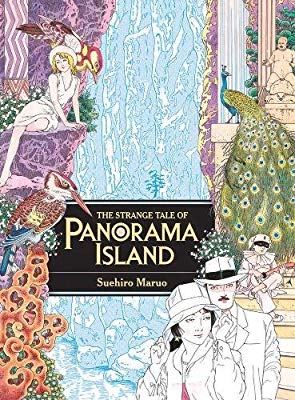 By SUEHIRO MARUO (Last Gasp; 2008/13)
By SUEHIRO MARUO (Last Gasp; 2008/13)
Very likely the magnum opus of Japan’s ero-guro master Suehiro Maruo (of MR. ARAHSI’S AMAZING FREAK SHOW, ULTRA-GASH INFERNO and many other sickies), this an absolutely stunning manga adapted from Edogawa Rampo’s 1926 novella THE STRANGE TALE OF PANORAMA ISLAND. The English language version of this masterwork has been a long time coming—Last Gasp initially announced it back in 2010, followed by three years of frustrating delays—but it’s here at last, and turns out to have been well worth the wait. (Interestingly enough, the original Edogawa Rampo novella also made its English language debut in 2013, courtesy of University of Hawaii Press.)
As related through Maruo’s highly fractured, surreal storytelling, it’s the story of Hitomi, a failed novelist residing in 1926 Japan. Upon learning of the death of the fabulously wealthy Komoda, and old school chum, Hitomi conceives a diabolical plan: closely resembling Komoda in all particulars, Hitomi decides to become him. This entails some macabre machinations–which, in characteristic Maruo fashion, Hitomi thinks up while having sex with a prostitute—that include a faked suicide and the disposal of Komoda’s corpse.
From there Hitomi/Komoda wastes no time putting the main part of his plan into action, utilizing Komoda’s vast fortune to create an island paradise characterized by vast panoramic landscapes and stocked with various human oddities. Inevitably, however, things turn twisted, with debauchery and perversion overtaking Panorama Island. Further obstacles include Komoda’s widow Chiyoko, who more then anyone else is capable of seeing through Hitomi’s ruse, and the fact that Hitomi unwittingly laid out his plans for Panorama Island in a pulp novel published years earlier.
All of the above is taken largely intact from the Rampo novella, yet this manga is thoroughly representative of Suehiro Maruo’s sensibilities in its perversely surreal air and frank depictions of sex and violence that would never have been allowed in Rampo’s day (meaning this is definitely an adults-only publication). The densely detailed yet elegantly simple black-and-white artwork represents Maruo at the height of his illustrative power, with astonishing depictions of the wonders of Panorama Island that strikingly but unobtrusively incorporate imagery from famous paintings–most notably Hieronymus Bosch’s “Garden of Earthly Delights,” several details from which are on display in the climactic pages. Perhaps in the coming years Suehiro Maruo will officially join the ranks of Bosch and other masters of artistic weirdness, and if so THE STRANGE TALE OF PANORAMA ISLAND will be among the foremost reasons why.
